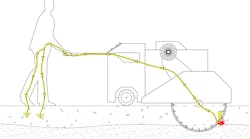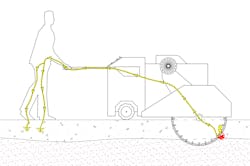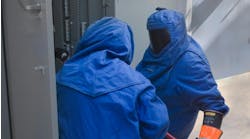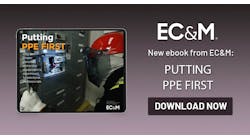When a rapidly growing packaging plant decided to once again expand its main manufacturing facility, the company faced a long yet familiar renovation road ahead. Through addition after addition, what was once a single building had now grown many times over into a large office, manufacturing, and distribution complex. As is the case with many building expansions, operations in the older sections moved into the new additions, and their former homes were then repurposed.
In this case, the company wanted to expand its production area into a warehouse section of the complex. A large extruder, which outputs rolls of plastic sheeting that make up the various packets, bags, and wrappers for the final product, was required in the new production area. The packaging company coordinated the construction and hired individual contractors to remodel the warehouse and update the utilities.
The Scene
The extruder weighed several tons, which was much greater than the concrete foundation floor of the warehouse could handle. A 30-ft × 115-ft rectangle of concrete needed to be cut out of the approximately 60-ft × 150-ft warehouse floor to accommodate the footprint of the extruder. The concrete pad section was further divided into 5-ft × 5-ft sections that could be removed with a front end loader. The ground below the foundation would then be dug out to accommodate a thicker, 18-in. reinforced concrete foundation to handle the additional weight of the extruder.
This particular project required the use of a gas-powered, walk-behind cutting saw with a 38-in. blade. To use this tool, a constant stream of water jets onto the blade and cutting surface to prevent the otherwise heavy dust generated by the cutting operation from blowing into the warehouse. As the operator walks along with the self-propelled saw, another worker follows behind and uses a floor vacuum to remove the slurry. Although the cutting process doesn’t seem complicated, a hidden electrical hazard awaited the unsuspecting workers.
The Accident
Jared had worked for XYZ Heavy Construction, the company hired to replace the foundation below the new extruder, for about 16 yr prior to this project. He had cut out sections of concrete and asphalt at least 20 to 30 times before, including other areas of the packaging company. Although he never received any specific training, he was familiar enough with the operation of different types of cutting saws and cutting procedures in general.
The day of the incident was also Jared’s first day of work on this particular job. After meeting with the on-site foreman for XYZ at 7 a.m., the project manager for the packaging company made a rough sketch of the foundation area to be removed and told the guys to get to work. XYZ employees asked if there were any potential utility services (water lines, electrical conduits, etc.) in the area they needed to be aware of. According to Jared, the answer was no.
Jared and other XYZ workers took a few hours to measure and lay out the extruder footprint, eventually denoting it with a black marker. It took another hour or two to set up the saw and vacuum equipment. Once they were ready, Jared began his first cut along one of the 115-ft edges of the extruder footprint.
As he moved along the perimeter with the saw, he moderated the cutting depth based on the resistance on the blade and the type of material thrown up with the saw (dirt vs. concrete). In this case, the concrete floor was on average 8 in. to 10 in. thick. Wearing his normal construction outfit of jeans and a T-shirt along with regular work boots, leather gloves, eye-protection, and a hard hat, Jared walked along the right side of the saw in order to make sure he was following the cutting line, steering the saw with his left hand.
He had traveled approximately 80 ft during his first cutting pass when the arcing event occurred. After seeing a blue arc come out of the saw, he felt an electrical shock and was immediately thrown to the floor. Jared later reported that the saw itself jumped up from the cutting track due to the force of the blast.
Unfortunately, none of the other workers saw the incident. The worker operating the vacuum was several feet behind Jared and didn’t initially notice anything. Once the XYZ foreman saw Jared sitting on the floor 10 ft to 15 ft away from the now non-operating saw, he quickly went over to him. He found Jared pale, shivering, and shaking. “I got zapped,” Jared told him.
Investigation and Analysis
The legal case in this matter tended to revolve around whether the presence of the electrical conduits was known prior to the incident — and if that information was properly communicated to the building contractor. Other legal questions related to whether Jared was properly notified of the risks involved in cutting concrete and if proper personal protective equipment (PPE) was worn.
Apparently, no photographs were taken immediately after the incident, and very little documentation was produced regarding the initial, informal investigation by XYZ and the packaging company. As a result, our analysis was limited to examining medical records, reading depositions of the various people involved in the incident and remodeling project, and trying to simulate the most viable cause of the incident.
Photographs taken during construction of the warehouse 3 yr prior were eventually found and produced as evidence in the civil lawsuit. They show several metal conduits traveling along the subfloor of the warehouse that were later covered and encased in the concrete foundation.
We did not receive any evidence that the conduits were incorrectly installed according to the NEC, although the specific installation of the conduits is unknown. Liquidtight flexible nonmetallic conduit (LFNC) [356.10(7)], rigid polyvinyl chloride conduit (PVC) [352.10(G)], electrical metallic tubing (EMT) [358.10(B)], and other types of conduit may be encased in concrete, but if the foundation and/or the conduits are in contact with the earth, the conduits must be rated for the appropriate corrosion resistance for the wet location (see Art. 100 for definition of Location, Wet”). According to Table 300.5, conduits running under a building have no minimum burial distance, so that must be kept in mind when cutting operations occur.
Deposition testimony later showed that a large, 480V, 3-phase, air turnover unit located in the warehouse lost power at the time of the incident, as did some of the 120V receptacles mounted on the perimeter walls of the warehouse. The circuits originated from 480/277V and 208/120V panelboards located in an adjoining building. The circuit breakers protecting these circuits also tripped.
It is likely Jared cut through the energized conduits and conductors during the incident. Cutting through the 277V phase-neutral conductors created a fault path through the saw and/or conduit to earth. However, it also created a parallel fault path through the saw, through Jared’s left arm, and down his body to the electrical earth ground of the concrete foundation (click here to see Figure).
When the electricity traveled through Jared’s body, it affected his muscles, causing involuntary contractions. The contraction of his left arm was severe enough to tear his bicep. The shock path also likely caused his leg muscles to contract, causing him to “jump” away from the saw.
Evidence discovered as a result of the various depositions revealed the packaging company’s lack of knowledge regarding the possible hazards below the floor of the warehouse. The piecemeal construction of the building resulted in there being no unified set of building plans. The packaging company only had the original construction plans for the warehouse — no plumbing or electrical drawings were available.
Instead of going back to the electrical contractor who originally installed the electrical system in the warehouse for further confirmation, other packaging company employees were asked whether they thought there were any hidden utilities under the floor. They also discussed the situation with an electrical contractor working on the new extruder addition. The information we received was contradictory regarding who knew what and when. But either way, the packaging company, the electrical contractor for the extruder project, and XYZ agreed there were no potential hazards under the warehouse floor during their meeting on the morning of the accident, which led to the initial floor cutting operation.
Lessons Learned
If further investigation had been done prior to the start of construction, it would have revealed the existence of electrical plans in the possession of the original electrical contractor. This would have at least given all parties notice that hazards did exist, which could be further identified by using a circuit tracer and cable locator to determine the actual path of the conduit runs beneath the concrete.
Even if the electrical plans were not found prior to construction, one could still attempt to determine the existence of pipes, conduits, cables, etc., using an outside contractor to examine the extruder footprint with x-ray equipment or ground-penetrating radar. Both of these methods are well known ways of mapping out unknown underground utilities.
OSHA statutes require all employers to inform their employees of the risks involved with their job and provide them with the appropriate PPE. In particular, OSHA 29 CFR 1910 and 29 CFR 1926 regulate safety and health in general industry and construction, respectively. Section 1910.132(d)(1) states: “The employer shall assess the workplace to determine if hazards are present, or are likely to be present, which necessitate the use of personal protective equipment (PPE)…”
The argument against XYZ Construction is that it did not perform this task to the best of its ability. Furthermore, it did not provide the appropriate PPE to employees performing concrete cutting operations, as provided in the OSHA statute 29 CFR 1926.29(a), which states: “The employer is responsible for requiring the wearing of appropriate personal protective equipment in all operations where there is an exposure to hazardous conditions or where this part indicates the need for using such equipment to reduce the hazards to the employees.”
In this case, cutting concrete where known or unknown electrical lines may exist is referred to in 29 CFR 1926.416(a)(2): “In work areas where the exact location of underground electric power lines is unknown, employees using jack-hammers, bars, or other hand tools which may contact a line shall be provided with insulated protective gloves.”
Further, protective footwear is also required according to 29 CFR 1910.136(a): “Each affected employee shall wear protective footwear when working in areas where there is a danger of foot injuries due to falling or rolling objects, or objects piercing the sole, and where such employee’s feet are exposed to electrical hazards.”
Protective gloves need to be designed and manufactured according to ASTM standard D 120: Specification for Rubber Insulating Gloves as well as rated for the appropriate voltages that may be encountered. Insulating footwear should be rated “DI”, for dielectric shoes, and rated according to ASTM F 1117: Specification for Dielectric Overshoe Footwear.
According to OSHA standards, employers are also required to train their employees to recognize potential hazards and determine when PPE is necessary. Because Jared did receive many hours of training during his work history with XYZ, he probably should have been able to recognize hazardous conditions on his own and request mitigation and/or PPE. However, his prior history of accident-free concrete cutting and his position in the company may have discouraged him from questioning the safety of this particular project.
The Outcome
As a result of this incident, XYZ Construction changed its policy and procedures regarding concrete cutting. Now, it brings in a utility locating company if the building owner states that there are underground conductors in the area — or if the as-built plans show such lines. It also requires workers to wear insulated gloves and boots. The packaging company hired an electrical contractor to produce electrical drawings of the building systems.
Eventually, the lawsuits against XYZ Construction and the packaging company were settled confidentially out of court for an undisclosed amount prior to trial. Had OSHA investigated this claim, XYZ could have been fined based on the violations uncovered during our analysis.
One final note to keep in mind on this case is that you, as electrical professionals, are aware of the hazards involved when dealing with electricity. Therefore, it’s critical to coordinate with all parties involved to ensure that safety is paramount. Keep clear and accurate records/plans of your work, provide the same to your client at the conclusion of a project, and keep archive copies on-hand in case incidents such as this arise.
Paris is a forensic electrical engineer with Anderson Engineering, New Prague, Minn. He can be reached at [email protected].
Sidebar: Best Practices for Safe Cutting Procedures
The Concrete Sawing and Drilling Association (CSDA), the leading trade group representing concrete sawing and drilling companies, offers many safety and construction training courses/documents. It has also worked directly with OSHA to produce a best practices document regarding electrical safety. CSDA-OBP-1004, issued in 2010, lists a variety of electrical safety concerns, involving both underground electrical services and the electrical components of the saw itself. Below are a few items of significance from its best practices document that relate to this case.
Electricity is widely recognized as a potential workplace hazard, exposing employees to electric shock, burns, fires, and explosions. Working on or around electrical conductors and equipment can be particularly dangerous, because electrical energy often cannot be sensed until contact is made. Apply the following guidelines to maximize safety:
1. On a daily basis, before starting any task, inspect the work area for possible electrical hazards. Take all necessary precautions to avoid cutting into electrical lines. In work areas where the exact location of the electrical power is unknown, power in the general vicinity of the building should be de-energized.
2. Operators should wear ASTM F 1117 dielectric boots and ASTM D 120 rubber insulating gloves. Leather protector gloves that meet ASTM F 696 should be worn over insulating gloves to prevent damage. Instruct each employee on how to recognize and avoid unsafe conditions that apply to the work areas.




